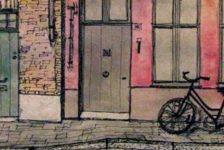A look at how the inevitable technology of automated cars will change the face of landscape architecture. Paradigm shifts in technology, through history’s lens, have proven to profoundly alter our society. This new technology, whether it be a printing press, cotton gin, nitrogen based fertilizer, car, or a computer sets a benchmark on how we function as a people. Its tendrils seep into our culture, economics, and a myriad of other locations – but one aspect that often gets overlooked is our landscape. Our cities were built to be the backbone support of the industrial revolution. Our roads were built to accommodate the car and truck. Our soil is radically altered due to fertilizers and farm practices of the past. Time and time again we can look at the trend of technology being introduced and a few decades later it fundamentally changes the way we look at the landscape.

How has the industrial revolution influenced landscape architecture? Image credit: Hartmann Maschinenhalle 1868 Public Domain
Get out of the way, automated cars are coming!
Automated cars are here and they work. From test upon test these vehicles have proven safer than human driven cars, and the automated ones are only getting better. They have driven successfully over 700,000 thousand miles on city streets, highways, and residential roads. While their primary function as a regular car is similar with an already laid out road system, I call that as automated cars become assimilated to our roads it will alter not just the roads themselves but the landscape around them. WATCH: Google Self-Driving Car Project Basic designs of our roads are posed to be altered with the introduction of the automated car. Highway lanes may expand or reduce in number depending on how a “constant speed” may change the road. On and off ramps could look virtually different. Our residential roads could accommodate the pedestrian much more.

Will all our roads become scenic landscapes? West Virginia Winding Autumn Trees Country Road. Credit: ForestWander; CC 3.0
- 6 Reasons Why Our Future Depends On Landscape Architecture
- Will These Solar Roadways Change The World?
- Visionary Smart Cities Offer a Glimpse of The Future
WATCH: Benefits of Mining Operation Automation | Caterpillar The Future’s Looking Bright I am hopeful that this new invention along with many other amazing new products will help better or world. I am optimistic that it will benefit not just landscape architecture but our environment as well. The automated car has the potential to affect so much of the world around us, and better it at that. My original question was, “how will automated cars change landscape architecture?”, and the answer to that is, I don’t know. No one knows, but what is important is that we try to know. We try and design new things to support the automated cars industry. This new tool is something that will change our landscape and landscape architects need to have their hands on the wheel of that change, instead of another profession. The automated car has the potential to become a prominent tool in our pockets and what’s important is that we utilize it. Article by Kevin Pfeiffer Return to Homepage Featured image: Highway 401 by 401-DVP CC BY 2.0 Nayu Kim
Published in Blog






